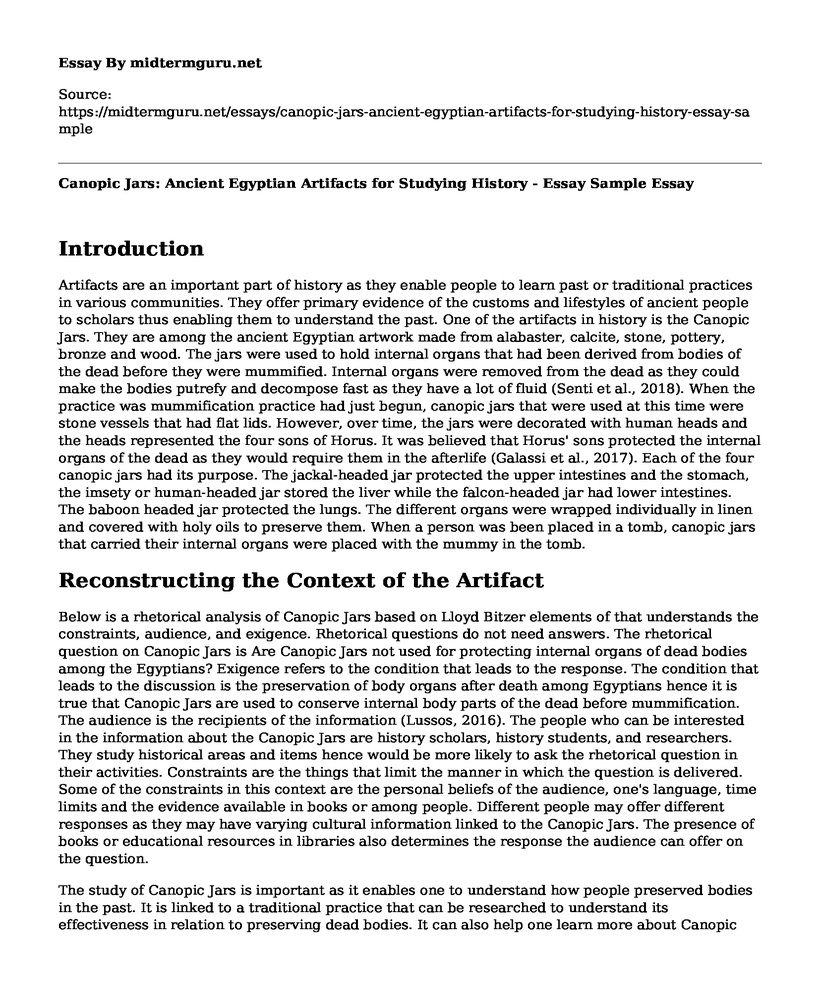Introduction
Artifacts are an important part of history as they enable people to learn past or traditional practices in various communities. They offer primary evidence of the customs and lifestyles of ancient people to scholars thus enabling them to understand the past. One of the artifacts in history is the Canopic Jars. They are among the ancient Egyptian artwork made from alabaster, calcite, stone, pottery, bronze and wood. The jars were used to hold internal organs that had been derived from bodies of the dead before they were mummified. Internal organs were removed from the dead as they could make the bodies putrefy and decompose fast as they have a lot of fluid (Senti et al., 2018). When the practice was mummification practice had just begun, canopic jars that were used at this time were stone vessels that had flat lids. However, over time, the jars were decorated with human heads and the heads represented the four sons of Horus. It was believed that Horus' sons protected the internal organs of the dead as they would require them in the afterlife (Galassi et al., 2017). Each of the four canopic jars had its purpose. The jackal-headed jar protected the upper intestines and the stomach, the imsety or human-headed jar stored the liver while the falcon-headed jar had lower intestines. The baboon headed jar protected the lungs. The different organs were wrapped individually in linen and covered with holy oils to preserve them. When a person was been placed in a tomb, canopic jars that carried their internal organs were placed with the mummy in the tomb.
Reconstructing the Context of the Artifact
Below is a rhetorical analysis of Canopic Jars based on Lloyd Bitzer elements of that understands the constraints, audience, and exigence. Rhetorical questions do not need answers. The rhetorical question on Canopic Jars is Are Canopic Jars not used for protecting internal organs of dead bodies among the Egyptians? Exigence refers to the condition that leads to the response. The condition that leads to the discussion is the preservation of body organs after death among Egyptians hence it is true that Canopic Jars are used to conserve internal body parts of the dead before mummification. The audience is the recipients of the information (Lussos, 2016). The people who can be interested in the information about the Canopic Jars are history scholars, history students, and researchers. They study historical areas and items hence would be more likely to ask the rhetorical question in their activities. Constraints are the things that limit the manner in which the question is delivered. Some of the constraints in this context are the personal beliefs of the audience, one's language, time limits and the evidence available in books or among people. Different people may offer different responses as they may have varying cultural information linked to the Canopic Jars. The presence of books or educational resources in libraries also determines the response the audience can offer on the question.
The study of Canopic Jars is important as it enables one to understand how people preserved bodies in the past. It is linked to a traditional practice that can be researched to understand its effectiveness in relation to preserving dead bodies. It can also help one learn more about Canopic Jars as different people are likely to have gathered varying information on the topic hence enable one to learn and understand them. Some of the questions a critic is likely to ask as follows: 'Do people use oil to preserve internal body organs from dead bodies?', 'Are the four types of the Canopic Jars used to preserve different body organs?' and 'Are the Canopic Jars named after Horus' sons?'.
There are no existing rhetorical analyses of Canopic Jars. I did online research on books, periodicals and journal articles and did not find any previously done research on rhetorical analysis of Canopic Jars. Therefore, the rhetorical analyses of the jars will be the first.
References
Galassi, F. M., Habicht, M. E., Bouwman, A., & Ruhli, F. J. (2017). The Canopic Jar Project: interdisciplinary analysis of ancient mummified viscera. CIPEG Journal: Ancient Egyptian & Sudanese Collections and Museums, (1), 75-79.
Lussos, R. G. (2016, September). The Multiperspectival Rhetorical Situation as a Method for Rhetorical Analysis and Communication Development. In Proceedings of the 34th ACM International Conference on the Design of Communication (p. 46). ACM.
Senti, S., Habicht, M. E., Rayo, E., Eppenberger, P. E., Ruhli, F. J., & Galassi, F. M. (2018). Egyptian Canopic Jars at the Crossroad of Medicine and Archaeology: Overview of 100 Years of Research and Future Scientific Expectations. Pathobiology, 85(5-6), 267-275.
Cite this page
Canopic Jars: Ancient Egyptian Artifacts for Studying History - Essay Sample. (2022, Dec 27). Retrieved from https://midtermguru.com/essays/canopic-jars-ancient-egyptian-artifacts-for-studying-history-essay-sample
If you are the original author of this essay and no longer wish to have it published on the midtermguru.com website, please click below to request its removal:
- First and Second Reconstruction - Essay Example
- Historical Significance of Harriet Tubman - Essay Example
- History of Abraham Louis Breguet - Research Paper
- Speech Analysis Essay on The Ballot or the Bullet
- Essay Sample on US Invasion of Iraq in 2003
- Americans' Support of Vietnam War: Cold War Causes and Effects - Essay Sample
- Maximizing Learning Outcomes in Culturally and Linguistically Diverse Settings - Essay Sample







